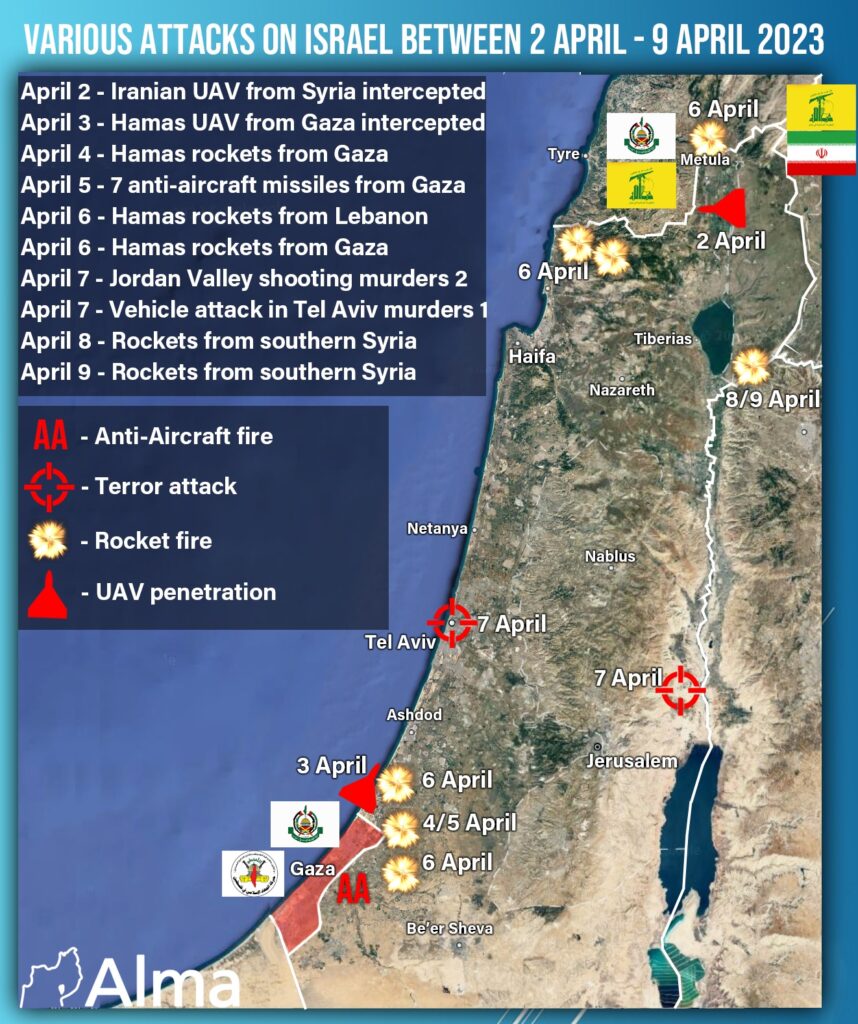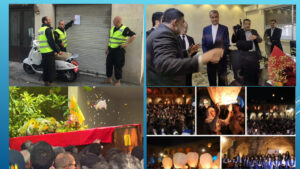Article by: Sarit Zehavi & Tal Beeri
What are the interests of the various players?
Do all roads lead to Tehran? For a long time, the Iranians have been trying to set the area ablaze while separating themselves from the events so that it will appear as if the deterioration began from “within,” i.e., from within Israeli territory by generating incitement on social networks (See our article from October 2021 on the subject Iranian Digital Influence Campaign On Israeli Social Networks), stirring up the events on the Temple Mount under the slogan “Al-Aqsa is in danger” (in practice, this is blatant fake news that is not connected to reality), and demonstrations in Arab villages inside Israeli territory. The attack in Megiddo (March 13) also occurred as a differentiation scheme attempting to misrepresent the act as though its planners and perpetrators originated from Judea and Samaria. It is important to note that Iranian activity to set the area ablaze takes place throughout all year, with the Ramadan days serving as incendiary material to intensify the activity.
Is this propaganda video published (April 5) on the Telegram channel, “Azzam al-Abbas, ” associated with Hezbollah, hinting at what happened on April 06? All the signs show that Hezbollah is ready for escalation and may even cause an escalation.
In our assessment, Iran is analyzing the strategic situation based on a sense of self-confidence and strength compared to Israel’s weakness (from an Iranian perspective). This Iranian analysis stems from several factors the Iranians interpret as acting to their advantage.
- The internal crisis (political/social) in Israel: While in Iran, demonstrators are shot, and some disappear, in Israel, tens and hundreds of thousands take to the streets relatively freely.
- A changing Middle Eastern arena? The capitulation of the Saudis and the Gulf States and the commencement of an open dialogue with Iran and Syria, i.e., the Shiite axis, is no longer isolated. The moderate Arab states have not changed sides (yet), and it is clear that they are acting based on certain interests. However, from Iran’s perspective, the renewal of relations is a great Iranian success. It should be noted that Iran and Saudi Arabia (with Chinese mediation) are about to mutually reopen their embassies, Syria will be reinvited to the Arab League summit held in Saudi Arabia in May 2023, Saudi Arabia and the Gulf states are renewing diplomatic relations with Syria, and the Houthis in Yemen is about to sign a ceasefire with the Saudi-led coalition joint with the United Arab Emirates.
- As of this writing, the Iranians have not yet paid the price for their progress in the military nuclear project. As far as they are concerned, Western countries (the US and Europe) are exhibiting their weakness.
- The deepening of security relations and cooperation with Russia with a sense of Iranian superiority, when even the Russians might need their help and may even depend on them in certain circumstances.
- Political weakness and a decline in American influence worldwide and in the Middle East in particular.
Note – make no mistake. The Saudis do not see the Chinese or the Iranians as allies. However, the Saudis feel insecure regarding their relations with the United States and fear the maturation of the Iranian nuclear project. This leads to a Saudi interest in keeping all channels open. All this goes beyond their deep economic interests and those of the Gulf states in Syria, Iraq, and Yemen. The Saudis do not want to leave these arenas, leaving them as an exclusive playground for the Shiite Axis.
In our assessment, the extensive rocket fire from Lebanon (April 6), led by Hamas-Lebanon’s military infrastructure, could not have taken place without some operative support from Hezbollah. At the least, Hezbollah allowed Hamas access to the launching zones in southern Lebanon, which are private agricultural areas, some of which are owned by Shiites.
Since the summer of 2022, Hezbollah has changed its perception and is ready to go to war with Israel. Nasrallah already disseminated the ideological and religious legitimacy against the background of the “Karish” maritime negotiations. Hezbollah’s increased daring acts can be witnessed through incidents and its presence on the blue line, with the high probability that they are also responsible and involved in the Megiddo attack (March 13). Hezbollah has maintained its operational readiness after the civil war in Syria and the COVID-19 pandemic (both in terms of the readiness of its operatives and in the context of weapons readiness).
Publicly, Hezbollah has made its affinity with the Al-Aqsa mosque clear. For years it has been a partner in the incitement and fueling of the “Al-Aqsa is in danger” narrative. Hashem Safi Al-Din, head of Hezbollah’s Executive Council and considered the leading candidate to succeed Nasrallah, said a few days ago that “the Zionist effort to harm the Al-Aqsa Mosque and harm our holy sites will ignite the region”…
What is Hamas’ interest in escalating during this period? It is in Hamas’ interest to constantly maintain a state of escalation vis-à-vis Israel, and not necessarily during this period. However, Hanas does not want to do so from the Gaza Strip, which it controls and where he must be accountable to nearly two million residents and their economy. Therefore, Hamas has taken care and will make sure to create alternatives in the form of escalation from Judea and Samaria and escalation from Lebanon (it should be noted that in Syria, Hamas has been absent since the beginning of the civil war in 2011, after being expelled for supporting the opposition). In Judea and Samaria, Hamas is having difficulty establishing a military infrastructure. In Lebanon, it succeeded in establishing a significant military infrastructure. In this way, on the one hand, it can differentiate the Gaza Strip and, on the other hand, preserve its interests as the “defender of Al-Aqsa” while preserving the (false) narrative of “Al-Aqsa is in danger,”, especially during Ramadan.
On the surface, despite their ideological differences, Shiite Hezbollah and Sunni Hamas demonstrate a unity of interests, mainly against Israel. The common interest allows the radical Shiite axis led by Iran to cooperate with the Sunni Muslim Brotherhood, represented by Hamas. Instead of a different religious ideology, a common ideological doctrine is created – the “ideology of Palestine.” Iran sees Hamas as a leader in the Palestinian arena, and therefore, as far as Iran is concerned, “there is no choice” but to embrace Hamas and keep it close. Hamas, as far as it is concerned, also understands that “there it has no choice” and that Iran (and Hezbollah) is the only source of military and financial aid.
Despite what has been seen in the various media outlets in the Arab world in particular and around the world in general, the trigger for the escalation and attack on Israel is not the access of the Israeli police into the Al-Aqsa Mosque. Still, rather there is a clear desire on the part of the players, each with its own interest, to escalate the security situation inside Israel.
As for the Lebanese issue, anyone who thought that an international force could bring about a different reality is strongly recommended to recalculate their position. For this matter, see UNIFIL’s April 6 statement, which speaks for itself: “The situation on the Blue Line is very worrisome; talks are being held with both sides to calm the situation…” There is no condemnation of Hezbollah or Hamas.
Israel needs to formulate a new policy on the northern border. Recent events prove this. The various players want to turn the reality in northern Israel into the same reality that Israeli citizens have experienced in the surrounding Gaza communities for the past 20 years, i.e., rocket and terrorist attacks every few weeks. In reality, it is only a matter of time before another terrorist act from South Lebanon against Israel occurs…
Israel is strong. The resilience of its citizens is being proven right now as tens (even hundreds) of thousands of Israeli citizens travel and vacation all over Israel throughout the Passover holiday, including in areas adjacent to the Lebanese, Syrian, and Gaza Strip frontiers.
All options are open regarding the IDF’s response at the time, place, and variety of responses. We’re not sure that the response we’ve seen so far is the end of the story. We do not want to elaborate on forecasts/estimates and interpretations on this subject, and there is no point in dealing with guesses on this issue.
The dilemma remains: How do we create deterrence without creating escalation? This is while the other side is attempting to create an escalation. In our assessment, the answer lies not only in the northern border itself but also in simultaneous activity in the strategic arena in the Middle East and in cooperation with the United States.






